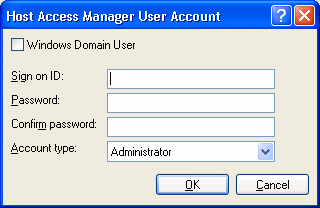User accounts tab
Use this tab to manage the management access rights to the cluster. These are the cluster management accounts, not the general
user accounts defined under Groups.

Host Access Manager provides five levels of access permissions as follows:
| • | Administrator: Administrators have full read/write permissions on the cluster. This level can be used by a master administrator with full responsibility over the configuration. |
| • | Day-to-day Admin: Day-to-day administrators have limited permissions. He/she has no authority on the server or cluster configuration other than changing his/her password in the cluster properties. |
| • | Group Admin: Group administrators have limited permissions on a specific group. |
| • | Manager: Managers have read-only permissions on almost all the configuration items. The only change that a Manager can perform is to reset a user's password using the right-click short-cut menu on the username. This level can be used by technical support personnel to unlock users who repeatedly enter the wrong passwords more times than permitted, or resetting their passwords when they forget them. |
| • | Monitor: Monitors have read-only permissions. This permission can be used to monitor the status of the cluster services and connected sessions without taking action. |
Administrator permissions details the specific permissions each administrator type is given.
Table 6: Administrator permissions
| Permission | Access type | ||||
|---|---|---|---|---|---|
| Administrator | Day-to-day Admin | Group Admin | Manager | Monitor | |
| Cluster properties | Y | N | N | N | N |
| Start/stop services | Y | N | N | N | N |
| Disconnect user/session: all | Y | Y | N | Y | N |
| Disconnect user/session: filtered | Y | Y | Y | Y | N |
| Add/remove license keys | Y | N | N | N | N |
| Add/remove/modify hosts | Y | N | N | N | N |
| Add/remove servers/cluster services | Y | N | N | N | N |
| Add/remove/edit groups | Y | Y | Y | N | N |
| Add/remove/edit users | Y | Y | Y | Limited | N |
| Add/remove/edit sessions | Y | Y | N | N | N |
| Assign sessions to groups | Y | Y | N | N | N |
| Assign sessions to users | Y | Y | Y | N | N |
| Edit keyboard layouts | Y | Y | N | N | N |
| Assign keyboards to languages | Y | Y | N | N | N |
| Clear cluster database | Y | N | N | N | N |
| HTML pages editing wizard | Y | N | N | N | N |
| Quick configuration wizard | Y | N | N | N | N |
You can create two type of accounts:
| • | a username/password combination for authentication |
| • | a Windows Domain account |
To create a new administrator account, click Add to display the following dialog box:

To add a username/password user, follow the steps below:
| 1. | In the Sign on ID field, type the sign-on name for the new account. |
| 2. | In the Password field, type the password for the account. |
| 3. | In the Confirm password field, retype the password for confirmation. |
| 4. | From the Account type drop-down list, select the account type that you want to assign to the account. |
Notes
| • | Usernames and passwords are case sensitive. |
| • | You cannot delete the default administrator account (Administrator) but you can change its password. |
To add a Windows Domain account, follow the steps below:
| 1. | Select the Windows Domain user check box. |
| 2. | Click on the ellipsis next to the Sign on ID. |
| 3. | Select one user (you cannot add more than one user at a time). |
| 4. | From the Account type drop-down list, select the account type that you want to assign to the account. |